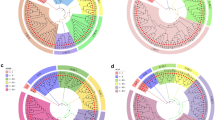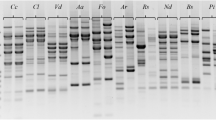Abstract
RLGS is a technique to detect DNA polymorphism using restriction sites as landmarks. It identifies the landmarks through direct end-labeling, two-dimensional electrophoresis and autoradiography, giving a profile with many spots to allow the scanning of numerous DNA loci. We successfully performed the technique on fungi using isolates ofColletotrichum acutatum andC. gloeosporioides in anamorphic Ascomycotina,Rhizopus oryzae in Zygomycotina,Phytophthora nicotianae in Mastigomycotina (or Oomycota) andRhizoctonia solani in anamorphic basidiomycotina. RLGS of total genomic DNA digested with three restriction enzymes,Not, I,EcoR V andMbo I, reproducibly gave specific profiles of ca. 400 to 1.600 spots for each isolate. A polymorphic spot appearing to reflect a genetic difference between the twoColletotrichum species was found in the profiles of the isolates. No other common spots were found in any combination of isolates of the twoColletotrichum species, and thus the other spots on the profiles were regarded as unique to each isolate. These results indicated that RLGS could be applied, as a powerful fingerprinting technique based on genetic information from the whole genomic DNA, to search for useful DNA markers for taxonomic and genomic studies on many fungal species.
Similar content being viewed by others
Literature cited
Alexopoulos, C. J., Mims, C. W. and Blackwell, M. 1996, Introductory mycology, 4th ed. John Wiley & Sons, Inc., New York.
Asakawa, J., Kuick, R., Neel, J. V., Kodaira, M., Satoh, C. and Hanash, S. M. 1994. Genetic variation detected by quantitative analysis of end-labeled genomic DNA fragments. Pro. Natl. Acad. Sci. USA91: 9052–9056.
Asakawa, J., Kuick, R., Nell, J. V., Kodaira, M., Satoh, C. and Hanash, S. M. 1995. Quantitative and qualitative genetic variation in two-dimensional DNA gels of human lymphocytoid cell lines. Electrophoresis16: 241–252.
Cavalier-Smith, T. 1986. The kingdom Chromista: Origin and systematics. In: Progress in phycological research, vol. 4, (ed. by Round, I and Chapman, D. J.) pp. 309–347. Biopress Bristol.
Dick, M. W. 1990. Phylum Oomycota. In: Handbook of Protocista, (ed. by Margulis, L., Corliss, J., Melkonian, O., and Chapman, D. J.), pp. 661–685. Jons & Bartlett Pub., Boston.
Dick, M. W. 1995. Sexual reproduction in the Peronosporomycetes (Chromistan fungi). Can. J. Bot.73 (Suppl. 1): S712–724.
Erwin, D. C. and Ribeiro, O. K. 1996. Taxonomic position ofPhytophtoora among living organisms. InPhytophthora diseases worldwide, (ed. by Erwin, D. C. and Ribeiro, O. K.), pp. 1–3. APS Press, St. Paul.
Farr, D. F., Bills, G. F., Chamuris, G. P. and Rossman, A. Y. 1989. Fungi on plants and plant products in the United States, pp. 1–5. APS Press, St. Paul.
Garber, R. C. and Yoder, O. C. 1983. Isolation of DNA from filamentous fungi and separation into nuclear, mitochondrial, ribosomal, and plasmid components. Analyt. Biochem.135: 416–422.
Hatada, I., Hayashizaki, Y., Hirotsune, S., Komatsubara, H. and Mukai, T. 1991. A genomic scanning method for higher organisms using restriction sites as landmarks. Pro. Natl. Acad. Sci. USA88: 9523–9527.
Hawksworth, D. L., Kirk, P. M., Sutton, B. C. and Pegler, D. N. 1995. Ainsworth & Bisby's dictionary of the fungi, 8th ed. CAB International, Wallingford.
Hawksworth, D. L., Sutton, B. C. and Ainsworth, G. C. 1983. Ainsworth & Bisby's dictionary of the fungi. 7th ed. Commonwealth Mycol. Inst., Kew.
Hayashizaki, Y., Hirotsune, S., Okazaki, Y., Hatada, I., Shibata, H., Kawai, J., Hirose, K., Watanabe, S., Fushiki, S., Wada, S., Sugimoto, T., Kobayakawa, K., Kawara, T., Katsuki, M., Shibuya, T. and Mukai, T. 1993. Restriction landmark genomic scanning method and its various applications. Electrophoresis14: 251–258.
Hirotsune, S., Shibata, H., Okazaki, Y., Sugino, H., Imoto, H., Sasaki, N., Hirose, K., Okuizumi, H., Muramatsu, M., Plass, C., Chapman, V. M., Tamatsukuri, S., Miyamoto, C., Furuichi Y. and Hayashizaki, Y. 1993. Molecular cloning of polymorphic markers on RLGS gel using the spot target cloning method. Biochem. Biophys. Res. Commun.194: 1406–1412.
Hosoya, T. and Otani, Y. 1997. Hyaloscyphaceae in Japan (1): Non-glassy-haired members of the tribe Hyaloscypheaea. Mycoscience38: 171–186.
Kawase, M. 1994. Application of the restriction landmark genomic scanning (RLGS) method to rice cultivars as a new fingerpinting technique. Theor. Appl. Genet.89: 861–864.
Kawase, M., Ishihara, J. and Tomioka, K. 1999. Detection of DNA polymorphism in Japanese rice cultivars using the restriction landmark genomic scanning (RLGS) method. Bull. Shikoku Natl. Agr. Exp. Stn.64: 37–46.
Kuick, R., Asakawa, J., Neel, J. V., Kodaira, M., Satoh, C. and Hanash, S. M. 1995. High yield of restriction fragment length polymorphisms in two-dimensional separations of human genomic DNA. Genomics25: 345–353.
Mills, P. R., Sreenivasaprasad, S. and Brown, A. E. 1994. Detection of the anthracnose pathogenColletotrichum. In: Modern assays for plant pathogenic fungi, (ed. by Schots, A., Dewey, F. M. and Oliver, R. P.), pp. 183–189. CaB International, Kew.
Murry, M. G. and Thompson, W. F. 1980. Rapid isolation of high molecular weight plant DNA. Nucleic Acids Res.8: 4321–4325.
Sato, T., Uematsu, S., Iijima, A. and Koganezawa, H. 1998. Occurrence of apple bitter rot by grayish colony form ofColletotrichum acutatum in Japan and pathogenicity to apple fruits ofC. acutatum andGlomerella cingulata isolated from other plants. Trans. Mycol. Soc. Japan39: 35–44. (In Japanese with English summary.)
Suzuki, H., Kawai, J., Taga, C., Ozawa, N. and Watanabe, S. 1994. A PCR-mediated method for cloning spot DNA on restriction landmark genomic scanning (RLGS) gel. DNA Res.1: 245–250.
Weitzman, I. and Silva-Hutner, M. 1967. Non-keratinous agar media as substrates for the ascigerous state in certain members of the Gymnoascaceae pathogenic for man and animals. Sabouraudia5: 335–340.
Yamaguchi, Y. 1976. Ecological studies of the tobacco black shank fungus under the underground condition modified by film-mulching cultivation. Bull. Kagoshima Tobacco Exp. Stn.20: 47–134. (in Japanese with English summary.)
Author information
Authors and Affiliations
About this article
Cite this article
Tomioka, K., Sato, T. Restriction landmark genomic scanning (RLGS) in fungi. Mycoscience 42, 295–299 (2001). https://doi.org/10.1007/BF02463922
Received:
Accepted:
Issue Date:
DOI: https://doi.org/10.1007/BF02463922




